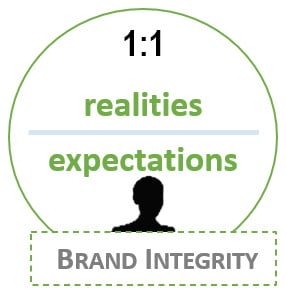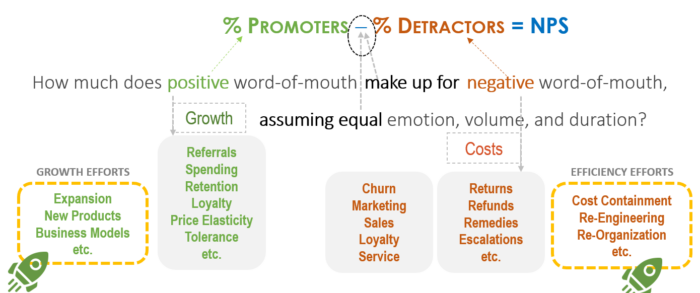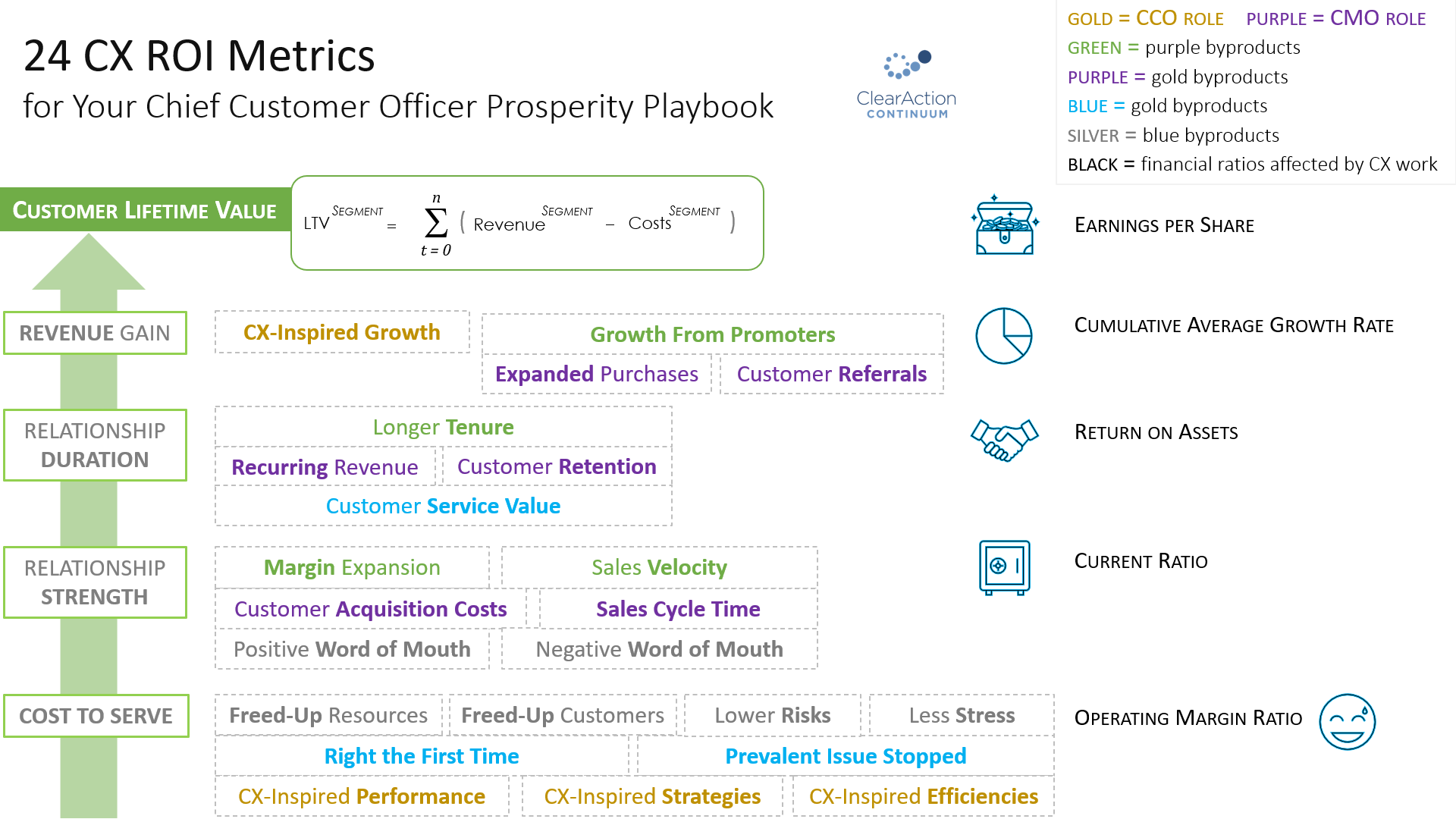 What is Customer Experience ROI? This is a question with a hundred different answers, inaccurately.
What is Customer Experience ROI? This is a question with a hundred different answers, inaccurately.
It’s not that complicated, but CX ROI advice is typically based on:
— Inside-out viewpoints rather than outside-in perspectives.
— A portion of customer experience management (selling, referrals, service, etc.).
Let’s get clear definitions for both parts of this question:
What is Return on Investment?
ROI is what’s gained for what’s given (or spent or invested):

A) The ROI equation is [[Gains minus Costs] divided by Costs] x 100.
— ROI is a cost-benefit analysis.
— It’s [The New Situation minus The Old Situation] divided by The Old Situation.
— Example 1:
$500 total revenue from something that cost you $400.
ROI = [$500 minus $400] divided by $400
= $100 divided by $400 = 25% revenue gain.
— Example 2:
3 hours is total time to do something that otherwise takes 4 hours.
ROI = [3 hours minus 4 hours] divided by 4 hours
= 1 hour divided by 4 hours = 25% time savings.
B) ROI is useful for evaluating choices and performance.
— Comparing different paths to take.
— Assessing productivity of people or a resource.
— Measuring value above a minimum standard (e.g. internal rate of return).
— Rewarding performance.

What is Customer Experience?
CX is a customer’s realities relative to their expectations.
— One person’s CX can be great for both luxury and discount competitors.
— Good experience = their realities meet or exceed their expectations.
— Bad experience = their realities are less than their expectations.
Customer Experience is what a customer experiences.
Customer Experience Management is how you manage what customers experience.
Meeting expectations is brand integrity:
— Say what you do and do what you say.
— Your brand has a value proposition: receiving value as-promised is integrity.
Their most important expectation is their intended ultimate outcome.
— Each step in a customer’s journey has an expectation: a task-to-be-done.
— Their ultimate outcome is their job-to-be-done: why they’re “hiring” you.
— It’s why they pursue your type of solution, from your brand specifically.
— There are usually 2-4 “ultimate outcome segments” per brand.
— Customers’ ultimate outcome should become North Star for everyone’s decisions.
CX ROI aims to maximize value per this North Star.
— Marketing and Sales manage customer expectations.
— Operations and the rest of your business deliver to expectations.
— Success and Service turn around potential churn.
— Churn is caused by North Star misalignment.
— North Star alignment minimizes costs and maximizes growth.
— CX Leaders’ role is distinct from the roles of CS and Marketing and Sales.
— CX Leaders ally with each C-Suite member for North Star alignment.
What is Customer Experience ROI?
CX ROI is value gained by customers plus value gained from customers.
Value gained from customers
1) Revenue minus cost to serve (essentially, this is lifetime value and earnings per share).
2) Inspiration for innovation, differentiation, and continuity (this is return on assets).
3) Brand preference, share of wallet, positive word-of-mouth (these are Marketing metrics).
4) Budget expansion via CX-inspired efficiencies and CX-inspired performance
(for more salary increases, profit sharing, hiring, and/or resourcing: for higher growth).
Value gained by customers
1) Stopping the root causes of things that bother customers.
2) Helping customers achieve their intended ultimate outcome.
3) Making it nicer to be your customer: more trust, more ease.
4) Demonstrating consistency in putting their interests first.
Calculations? Stay tuned for the next article in this 5-part CX ROI Handbook series:
Proving CX Value to Executives.
To connect financials to customer ratings, such as NPS, start by:
— Using whatever data you can readily access.
— Adding up costs (shown in the diagram below).
— Adding up the money gained (see the growth areas in this diagram).
— Comparing actual money gained versus money spent due to these customer behaviors.
If you do not collect customer ratings, you can still calculate this.

If ratings appear more positive than the gains minus costs, then:
— Ratings are likely inflated, due to bias you’ve introduced in data collection.
— Efforts to increase value gained by customers are insufficient.
— You’re under-emphasizing budget expansion as a personal motivator for engagement of executives and employees in the two “value gained” lists above.
To pique managers’ interest in driving “value gained by customers” see:
How to Quantify CX ROI.
Customer Lifetime Value is Your Ultimate Aim

Customer Lifetime value (CLV) is cumulative profit.
For a customer, account, segment, product, region, or total:
— Subtract total costs from total revenue
— For the duration of those customers’ relationship with your brand.
— If you can’t access total costs or total revenue, start with what you have.
— Welcome data owners and math experts to fine-tune your calculations.
— Be patient: over a few years of fine-tuning, you’ll increase lifetime value accuracy.
Customer Lifetime Value reports CX ROI realistically.
It supports each point listed in “What is Customer Experience” in this article:
— CLV reflects realities versus expectations.
Revenue increases with good experience.
Costs increase with bad experience.
Relationship duration increases with good experience.
— CX, CXM, and CLV are cumulative over time.
— CLV reflects brand integrity.
— CLV is maximized by aligning to customers’ ultimate outcome.
The ROI equation is not the best way to evaluate CX management.
— It’s a point in time, whereas CX, CXM, and CLV are cumulative over time.
— It ignores non-quantitative gains and costs.
— It sidesteps value such as low-revenue customers who inspire innovative thinking, etc.
— It’s about one thing at a time (a silo), instead of the dynamics in-play (holistic).
When you present ROI equations, tell decision-makers the full story with multiple data points and descriptions of status quo consequences and other potential consequences.
I call this Strategic ROI.
Customer Experience ROI Hierarchy

Manage CX ROI holistically to maximize value gained by and from customers.
Focus CX Leaders on the 4 gold CX ROI metrics:
— CX-inspired growth, performance, efficiencies, and strategies.
The 4 gold CX ROI metrics empower Marketing Leaders’ focus on:
— Expanded purchases, retention, recurring revenue.
— Referrals, acquisition costs, sales cycle time.
Natural results of CX Leaders’ + Marketing Leaders’ distinct efforts are:
— Sales velocity, margin expansion, tenure, and Promoters growth.
The 4 gold CX ROI metrics are your efficient and sustained path to:
— Right the first time, prevalent issues stopped, customer service value.
— Freed-up resources, freed-up customers, less risk, less stress.
— More positive word-of-mouth, less negative word-of-mouth.
Shortcuts abound in popular practices.
— You already have a Sales team, Marketing team, Service team, and Operations team.
— Focus your CX Leader’s core team on facilitating the 4 gold CX ROI metrics.
CX-Inspired Growth (1st of 4 Gold CX ROI Metrics)
Number of Transactions from New Growth Efforts times [Margin of CX-Inspired Efforts minus Margin of Internally Inspired Efforts].
— Use human-centered design (agile) for every growth effort:
Products, services, markets, mergers, partners, business models.
CX-Inspired Performance (2nd of 4 Gold CX ROI Metrics)
Productivity of Groups Using CX Insights minus Productivity of Groups Not Using CX Insights.
— Use CX insights as performance standards for every department companywide:
Define each work group’s effects on value gained by and from customers.
CX-Inspired Efficiencies (3rd of 4 Gold CX ROI Metrics)
Savings from Efficiencies Using CX Insights minus Savings from Efficiencies Not Using CX Insights.
— Use human-centered design (agile) for all cost containment efforts:
Process improvements, re-organizations, revising policies, etc.
CX-Inspired Strategies (4th of 4 Gold CX ROI Metrics)
Hours This Year minus Hours Last Year in Realignment Communications.
(for all work groups enterprise-wide: Hourly Average Salary & Fringe times)
— Use insights as the starting point for every department’s strategy companywide:
SWOT analysis, customers’ ultimate outcomes, effects on value gained by customers.
Note: There are more ways to calculate these 4 gold Customer Experience ROI metrics!
—The equations above are your starting point.
For definitions of each metric shown in the diagram above, see:
24 CX ROI Metrics for Your Chief Customer Officer Prosperity Playbook.
For guidance in driving the 4 gold CX ROI metrics, see:
How 4 CX Metrics Drive 20 Growth Metrics
For guidance in driving utilization of CX insights, see:
What’s Your Insights Utilization Rate? 24 Ways to Boost 2024 CX ROI
and Insights Utilization Rate Drives Growth Through Customer-Centric Organizations
Conclusion
Customer Experience ROI is top of mind because jobs depend on it.
— Executives are judged by ROI: talk about CX financial ratios (see chart above).
— Foster a holistic view via Strategic ROI, CLV, and the 4 gold CX ROI metrics.
— Focus CX Leaders on the 4 gold CX ROI metrics to stimulate the CLV hierarchy.
— Empower Marketing, Sales, Service, Success via the 4 gold CX ROI metrics.
Customers’ prosperity is your path to prosperity.
— Customers are the hand that feeds you.
— They pay for your salaries, budgets, and profit sharing.
— Investors go away when customers go away, not vice versa.
— Put the horse before the cart via outside-in revenue growth:
Engage everyone in driving value gained by customers.
This is the key to maximizing value gained from customers.
This article is the first in a five-part series:
1. Customer Experience ROI Handbook: What is CX ROI?
2. CX ROI Handbook: Proving CX Value to Executives
3. CX ROI Handbook: Connecting Employee Experience and Customer Experience ROI
4. CX ROI Handbook: Business Outcomes and Customer Outcomes
5. CX ROI Handbook: CX Dashboards and Compensation
Images licensed to ClearAction Continuum by Shutterstock.




Great read! Thanks a lot, Lynn. I wish I had your practical writing skills.
Thanks, Ricardo. It’s always nice to see readers’ comments. As you know, these articles sometimes require many (many, many) hours to fine-tune for ease of comprehension while striving to be comprehensive.
I’m excited for the next installments in this CX ROI Handbook 5-part series. In the meantime, I’ll be creating paths to fast-track that same info (and more) via Masterminds and other new ways to learn quickly and affordably.